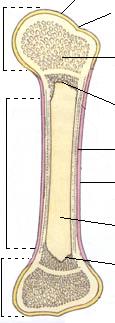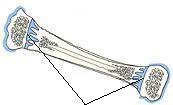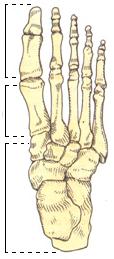
GCSE PE - Theory - Bones
This section contains course notes, useful web links, and sample exam questions.
Use the physed message board if you need to ask any questions.
p h y s e d
Contents:
New addition to the GCSE PE site.
Just press here for exam questions on 'bones' and send your answers to be electronically marked.
Composition of bones
Growth and development of bones
The process of ossification
Functions of the human skeleton
Naming the bones in the body
The five regions of the vertebral column
Classifying bones


Check here for a great site: http://www.innerbody.com/htm/body.html

physed
Message
Board
Composition of bones
Cartilage
Smooth and slippery, a bit like thick white plastic. Firm and elastic it protects the ends of the bone where it meets other bones.
A typical adult long bone
hyaline cartilage
Compact bone

joint surface
Hard and strong substance beneath the periosteum, forming the shaft of a long bone.
epiphysis -
Cancellous bone (spongy bone)
cancellous bone
A spongy substance found inside the compact bone. Hard, light and very strong. In some spongy bone the holes are filled with red marrow, which makes blood cells.
position of epiphyseal plate
Medullary cavity (marrow cavity)
compact bone
Filled with soft yellow pulp called marrow.
diaphysis -
periosteum
Periosteum
Tough fibrous membrane which covers all except the ends of the bone.
medullary cavity
Epiphysis
The end part of a long bone.
position of epiphyseal plate
Epiphyseal plate
diaphysis -
Growth plates.
Diaphysis
The shaft of a long bone.
Growth and development of bones
Bones begin to grow before children are born. At first the bones of the skeleton are made from cartilage tissue. As growth takes place the cartilage is hardened into bone by the addition of calcium and other minerals.
The development of bone from cartilage is called ossification (see below).

Development of bone at 15 years
growth occurs here
Bone growth begins in the centre of each bone (in the centre of the shaft of a long bone) with secondary growth appearing at both ends (epiphyseal plates). Growth stops when the plates are all bone.
The skeleton continues to grow until about the age of 13-15 in girls and 16-18 in boys.
Mature bones are hard, rigid non-elastic materials. Mature bones are made up of calcium compounds which give them hardness. Collagen fibres make them strong and light.
The process of ossification
Ossification, the development of bone from cartilage, continues through childhood until adulthood and occurs in three ways:
1) Normal bone growth from embryo (before birth) to maturity
2) Replacement of bone worn through normal daily activity
3) Repair of bone damaged by accident or over-use.
Even when a bone has stopped growing it is full of life. Bone cells called osteoblasts keep making new bone. At the same time other bone cells called osteoclasts break it down. Exercise puts pressure on your bones which makes the eosteoblasts work harder.
All bones get lighter as people get older because the osteoblasts don't work so hard. Many older women suffer from osteoporosis, where bones get so weak they break easily.
Bone growth and sport
Exercise helps the development of the skeleton in young people and is essential for proper bone growth. Exercise will increase bone width, bone density and, therefore, bone strength. It appears to have no affect on bone length. A lack of weight bearing physical activity will lead to loss of bone tissue in the skeleton and will, therefore, weaken bones (osteoporosis).
Injuries to bone need careful treatment to avoid damage to growth areas (eg. Osgood-Schlatter�s Disease [knee] and Sever�s Disease [ankle]). Flexibility is particularly important for young people whose bones are still growing. During periods of rapid growth there can be an increase in muscle-tendon tightness about the joints and loss of flexibility due to the bones growing much faster than the muscles stretch. Thus, it is recommended that children perform stretching exercises to consistently maintain flexibility and prevent injuries.
Functions of the human skeleton
Protection
Delicate parts of the body need protection.
a) The skull protects the brain
b) The vertebral column protects the spinal cord.
c) The rib cage protects the heart and the lungs.
Support
The body needs a skeleton to:
a) Hold the vital organs in place
b) Provide support for the body.
Movement
Muscles act on the bone to cause movement.
a) The skeleton is jointed which allows a wide range of movement.
b) Different joints allow various kinds of movement.
Blood Production
Red and White blood cells are produced in the marrow cavities of bones.
Calcium and other minerals are stored in the body.
Naming the bones in the body



The five regions of the vertebral column

Cervical
vertebrae (7)
Cervical vertebrae
Support back and head. Allow the most movement: bend and tilt head and look over shoulder.
Thoracic
vertebrae (12)
Thoracic vertebrae
Ribs connect to these. Do not move much, so heart and lungs do ot get squashed.
Lumbar vertebrae
Big, support the rest. Aloow plenty of twisting and turning. Powerful back muscles attach to the wings at each side.
Lumbar
vertebrae (5)
The Sacrum
Form one bone which is fused to the pelvic girdle. A solid base for trunk and legs.
The Coccyx
Sacrum (5 fused)
Our ancestors had tails. and this part got left behind!
Coccyx (5 fused)
relevance to sport
curved structure etc.
Classifying bones
There are four basic types of bone. Their size and make up are linked to how we use them.
Long
These are the large bones in our legs and arms. They are used in the main
movements of the body.
Short
These are the small bones at the joints of our hands and feet.
Flat
These are the bones of the skull, shoulder girdle, ribs and pelvic girdle. They
protect organs of the body. Large muscles can be attached to the flat bones.
Irregular
These are the bones in the face and vertebral column. They gave the body
protection and shape.
Bone Type Table:
Bone
Common Name
Bone type:
Cranium
Clavicle
Scapula
Sternum
Vertebral column
Ilium
Femur
Phalanges (hand)
Phalanges (foot)
Tarsals
Metatarsals
Carpals
Metacarpals
Fibula
Tibia
Patella
Ulna
Radius
Humerus
Ribs
Skull
Collar bone
Shoulder blade
Breast bone
Spine
Pelvis
Thigh bone
Toes
Fingers
Ankle
Foot
Wrist
Hand
Shin
Knee cap
Funny bone
flat
flat
flat
irregular
flat
long
long
long
short
long
short
long
long
long
flat
long
long
long
flat